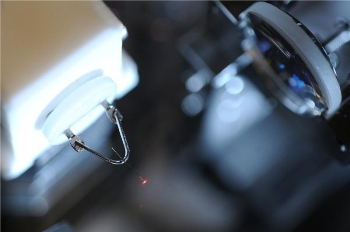Steering electrons with an electric field of femtosecond laser pulses resolves atomic procedures on an attosecond time scale.
 Tungsten Metal Tip
Tungsten Metal Tip
Dr. Peter Hommelhoff’s independent research group has applied this technique to very sharp metal tips. This enables scientists to prove that minute laser intensities are adequate to steer electrons from the sharp metal tip.
The observed modulation in the energy spectrum can be elucidated with an occurrence of a coherent interference of wave packets with numerical calculations. The device built by Ultrafast Quantum Optics represents a sensitive and compact system for calculating the phase of laser pulses. This could pave the way for developing optical transistors.
The experiment conducted by the research group comprises a tungsten tip, which is irradiated for a duration of few femtoseconds with light pulses. If the laser pulse’s intensity is adequate, the electrons can have the ability to absorb the necessary energy from the metal tip. They can then be registered by using a detector. Since the metal tip has a radius of approximately 10 nm, the laser light’s intensity gets substantially amplified. In the experiment, the kinetic energy and the number of emitted electrons are evaluated for various phase shifts. The electron spectrum’s structure is influenced strongly by the phase shift. The researchers displayed two spectra that took place with phase shifts varying by 180°.
The researchers also determined whether the spectra’s pronounced peaks can be observed. These peaks occur because of the electrons’ quantum mechanical wave nature. The electrons could be emitted at two time intervals at a 180º phase shift. The two wave packets’ interference at the metal tip paves the way to the spectrum’s interference spectrum. However, electron emission can occur only once per pulse if the phase shift is 0°. This eradicates interference and leads to the disappearance of maxima.
The scientists have concluded that the laser field influences the electrons’ motion even after the occurrence of emission from the metal tip. The constant count rate at high energies implies that the electrons can be driven back to the metal tip by the laser field. The scientists have, for the first time, steered electrons by using a femtosecond laser pulse. This technique is crucial for obtaining insight into the functioning of electrons in solid surfaces. By integrating an electron multiplier, a retardation grid, and a metal tip, compact units can be developed for measuring and the stabilization of the laser pulses’ phases.